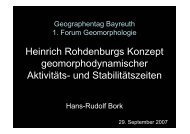Chapter 14 - Limitations on Predictive Modeling in Geomorphology ...
Chapter 14 - Limitations on Predictive Modeling in Geomorphology ...
Chapter 14 - Limitations on Predictive Modeling in Geomorphology ...
Create successful ePaper yourself
Turn your PDF publications into a flip-book with our unique Google optimized e-Paper software.
LIMITATIONS ON PREDICTIVE MODELING 353<br />
INAPPLICABILITY OF THE FACTOR OF SAFETY CONCEPT<br />
In eng<strong>in</strong>eer<strong>in</strong>g projects that affect property, life, or <strong>in</strong>cur large costs, the risk of a serious<br />
mismatch between predicti<strong>on</strong> and outcome can often be protected aga<strong>in</strong>st by <strong>in</strong>corporati<strong>on</strong><br />
of a factor of safety <strong>in</strong> eng<strong>in</strong>eer<strong>in</strong>g design. The factor of safety helps to protect aga<strong>in</strong>st a<br />
faulty design predicti<strong>on</strong> and aga<strong>in</strong>st larger than expected excursi<strong>on</strong>s of external forc<strong>in</strong>g<br />
parameters. Eng<strong>in</strong>eered systems are generally c<strong>on</strong>structed of synthesized or carefully<br />
selected materials and elements whose properties and <strong>in</strong>terrelati<strong>on</strong>ships with each other<br />
the eng<strong>in</strong>eer (ideally) understands. Thus, elements of a build<strong>in</strong>g or bridge are selected and<br />
assembled to desired specificati<strong>on</strong>s, <strong>in</strong> a manner over which the eng<strong>in</strong>eer has c<strong>on</strong>trol. If<br />
certa<strong>in</strong> elements of the system are not well-understood, or fail to meet specificati<strong>on</strong>s, they<br />
are rejected and elements or materials substituted whose behavior is acceptable. In short,<br />
eng<strong>in</strong>eered systems are designed and assembled, and design and human assembly imply a<br />
high level of understand<strong>in</strong>g and c<strong>on</strong>trol. C<strong>on</strong>sequently, model predicti<strong>on</strong>s can be effective<br />
for such systems, and factors of safety can be <strong>in</strong>cluded <strong>in</strong> the design.<br />
For geomorphic systems, however, the material properties and 'c<strong>on</strong>structi<strong>on</strong>' of the<br />
system (an alluvial surface subject to erosi<strong>on</strong> or depositi<strong>on</strong>, a river channel, a tidal <strong>in</strong>let)<br />
are not usually well-specified or well-c<strong>on</strong>trolled. In their natural state, these systems are<br />
not designed and assembled. Where efforts are made to eng<strong>in</strong>eer these systems, as <strong>in</strong> flood<br />
c<strong>on</strong>trol projects, success is due <strong>in</strong> large measure to the additi<strong>on</strong> of eng<strong>in</strong>eered structures<br />
(e.g. levees and dams) to the natural system - structures that <strong>in</strong>corporate a factor of safety.<br />
Thus the courses of c<strong>on</strong>crete-l<strong>in</strong>ed rivers <strong>in</strong> the Los Angeles bas<strong>in</strong> are predictable over<br />
many flood seas<strong>on</strong>s, and they seldom overflow their banks. Models that are used to predict<br />
behavior of a natural system (e.g. how an alluvial surface resp<strong>on</strong>ds to the forces of erosi<strong>on</strong><br />
follow<strong>in</strong>g clear<strong>in</strong>g of vegetati<strong>on</strong>) have much less predictive capability than models of<br />
typical eng<strong>in</strong>eered systems, because the elements of the natural system are not chosen and<br />
c<strong>on</strong>structed to predeterm<strong>in</strong>ed specificati<strong>on</strong>s. Envir<strong>on</strong>mental systems are highly<br />
heterogeneous, material properties are often little understood, and <strong>in</strong>itial c<strong>on</strong>diti<strong>on</strong>s are<br />
usually poorly known. It is not surpris<strong>in</strong>g that a number of famous dam failures,<br />
exemplified by the Sa<strong>in</strong>t Francis dam (Wiley et al. 1928) and the Vai<strong>on</strong>t dam (Kiersch<br />
1964) disasters, occurred primarily as the result of <strong>in</strong>itial 'failure' <strong>in</strong> geologic material<br />
adjacent to or upstream of the dam structure, not because the physical (eng<strong>in</strong>eered) dam<br />
itself failed.<br />
The factor of safety c<strong>on</strong>cept is basically a l<strong>in</strong>ear scal<strong>in</strong>g method. Where relati<strong>on</strong>ships<br />
between variables are highly n<strong>on</strong>l<strong>in</strong>ear, and a clear understand<strong>in</strong>g of the c<strong>on</strong>troll<strong>in</strong>g<br />
variables does not exist, as <strong>in</strong> many natural and envir<strong>on</strong>mental systems, the factor of<br />
safety c<strong>on</strong>cept is <strong>in</strong>applicable. Lack of a factor of safety results <strong>in</strong> a reduced probability<br />
that a system will behave <strong>in</strong> a desired (or known) way <strong>in</strong> the future, and hence leads to a<br />
reduced predictive capability.<br />
A substitute for a factor of safety <strong>in</strong> envir<strong>on</strong>mental predicti<strong>on</strong> is the worst-case scenario<br />
(Schumm 1985). While the factor of safety depends for its effectiveness <strong>on</strong> designed and<br />
tested c<strong>on</strong>structi<strong>on</strong> methods (mak<strong>in</strong>g a dam thicker), the effectiveness of the worst-case<br />
scenario <strong>in</strong> geomorphic applicati<strong>on</strong>s depends <strong>on</strong> the reliability of a model of an undesigned<br />
natural system. If the worst-case scenario represents <strong>on</strong>ly a modest deviati<strong>on</strong> from<br />
the c<strong>on</strong>diti<strong>on</strong>s under which the model was derived and calibrated, worst-case predicti<strong>on</strong>s<br />
are likely to be more useful than when the worst-case scenario represents extreme








